Table of Contents
The Precedence Research estimates that the global IoT applications market will reach approximately USD 618.37 billion in 2025 and exceed USD 3,644.20 billion by 2034. These numbers reveal the increasing value of the Internet of Things for business and the growing demand for IoT services in the coming years. But what makes IoT so popular and valuable for businesses across industries? This article discusses top IoT applications in various fields in 2025, their benefits, trends, and steps for businesses to adopt the technology smoothly.
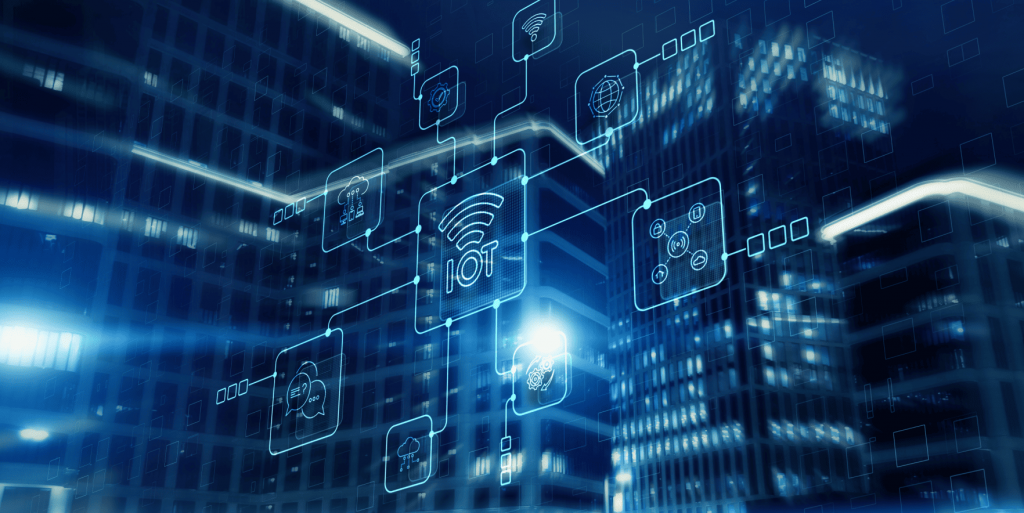
Understanding IoT: how does it work?
First, let’s clarify what IoT is and how it works. The Internet of Things is a network of connected physical devices with sensors that collect and exchange real-time data. Consider medical sensors that can collect real-time patient vitals, like blood pressure, send the data to a centralized storage, and alert doctors immediately. This is just one example of IoT in healthcare, and obviously, the technology can be used in many other industries.
Typically, IoT devices have built-in sensors that gather data, such as temperature, motion, GPS location, or other relevant information. The devices then transmit the collected data to a cloud server or a central storage for processing, where it is analyzed and transformed into actionable insights. These insights are then displayed to the end user through an application, dashboard, or other interface, enabling real-time monitoring and decision-making.
Key IoT components
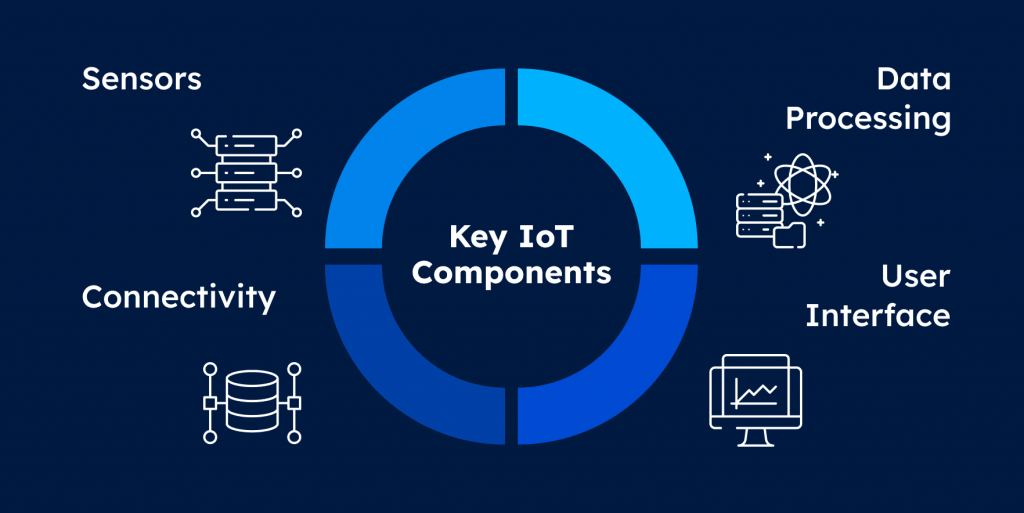
IoT comprises various components that help applications and linked devices function correctly:
Sensors
The first and most crucial parts of any IoT system are devices and sensors that collect data from the environment. These devices come in many types. On the simpler side, we have basic sensors that measure things like temperature, humidity, or light levels. On the more complex side, industrial IoT robots with multiple sensors and actuators can carry out detailed tasks.
These devices primarily gather the data, no matter how simple or complex it is. For instance, a temperature sensor records the temperature in a room, while an industrial robot checks its working status and looks for issues. After collecting the data, it is usually processed locally before being sent to other devices or central systems for further analysis.
Connectivity
Once the data is collected, it must be sent to the cloud or the on-premises data storage for processing and analysis. IoT connectivity includes Wi-Fi, Bluetooth, cellular networks, and satellite connections. The collected data is then transferred over the Internet via one of these technologies. Every connectivity method has its pros and cons in terms of power usage, range, and bandwidth. So, the optimal choice depends on the particular IoT use case. However, all methods ultimately serve the same purpose: secure data transfer to the storage.
Data processing
The transmitted data then undergoes some processing. Depending on the application, this processing can take place at the edge (close to the data source) or in the cloud.
Edge processing (or edge computing) minimizes delays and bandwidth consumption, as data is handled locally. This method allows systems to swiftly adapt to changes and ease the pressure on network infrastructure.
On the other hand, cloud processing provides greater computational power and more extensive storage options. It suits applications that analyze large-scale data and require long-term storage, like smart cities and healthcare systems. Think of a smart city as an example, where data from various sensors is processed in the cloud. It helps enhance traffic management, lower energy use, and improve public safety.
User interface
The UI provides a platform for users to visualize data, monitor performance, and manage their connected devices. A well-designed UI ensures that users can effortlessly access and understand the information they need, which is crucial for any IoT solution.
User interfaces can take many forms, such as mobile apps, web dashboards, or voice-activated assistants. For instance, a smart home app allows users to manage their lighting, temperature, and security from their smartphones. In industrial environments, web dashboards help teams monitor machinery and production in real time, while voice assistants like Amazon’s Alexa provide seamless, hаnds-free control over devices.
The effectiveness of the Internet of Things for business lies in their key components, which ensure data collection in real time, monitor different values, and help businesses make vital decisions. Yet, the real strength of IoT is also found in its capacity to automate processes, which makes tasks simpler and more effective.
How IoT is shaping the future of automation
IoT-based automation is an advantage for companies that want to optimize working processes, boost the quality of their products and services, and cut costs. There is a broad range of cases when automation helps organizations solve their pressing tasks. For example:
- Smart sensors, cameras, and robotics allow manufacturers to optimize processes, improve supply chains, and manage energy more effectively, which boosts quality and productivity. The Internet of Things helps monitor parameters such as temperature, humidity, vibration, and equipment conditions so manufacturers can predict equipment failures and take care of them in advance.
- IoT devices help monitor patients remotely in healthcare, especially after surgeries and other medical procedures, so patients get proper help, and doctors can adjust their treatment plans.
- IoT devices also enable smart farming. They help monitor soil moisture, nutrient levels, and crop health, thus reducing resource waste, optimizing irrigation, and improving yields.
- Smart city initiatives use IoT to improve urban living conditions. IoT solutions help adjust traffic lights in real time to reduce wait times and monitor neighborhoods to detect suspicious activities. They also monitor bin fill levels and track air quality, pollution, and environmental changes.
Why invest in IoT for business
Due to the versatile nature of IoT solutions for businesses, there are many reasons why companies invest in these applications. Core benefits of the Internet of Things in business include:
Real-time monitoring
IoT in business offers organizations the ability to oversee and control devices and systems from afar. Instead of sending someone to check equipment or inventory levels, companies can use sensors to monitor data remotely. This approach not only saves time and money but also enhances safety by minimizing the necessity for employees to enter potentially dangerous areas.
Predictive maintenance
IoT sensors continuously monitor machinery conditions, analyzing data such as temperature, vibration, and pressure to detect early signs of wear and tear. Together with data analysis driven by machine learning, the Internet of Things helps predict when machines and equipment need maintenance. This means less unexpected downtime and fewer costly repairs. According to Deloitte, predictive maintenance can lower maintenance expenses by up to 10% and improve uptime by 20%.
Depending on the business, IoT systems can help avoid accidents or unexpected events, which can save a lot of money over time. For industries where delays from issues cost a lot, being able to watch for and predict maintenance problems is vital for staying on budget.
Improved security
IoT applications can enhance security in many ways, both inside and outside businesses. For instance, in a retail environment, IoT sensors can monitor the inventory and notify security staff if any items are missing. Similarly, in an office, access can be managed through IoT-enabled badge readers, ensuring only authorized personnel can enter certain areas.
Data-driven decision-making
IoT devices gather real-time data, helping businesses make quick, informed decisions. By analyzing this data, companies can improve their processes, boost productivity, and react quickly to market needs. For example, IoT sensors can track production lines and provide insights that allow for quick adjustments to improve the quality of your new product.
Top 5 IoT use cases in business
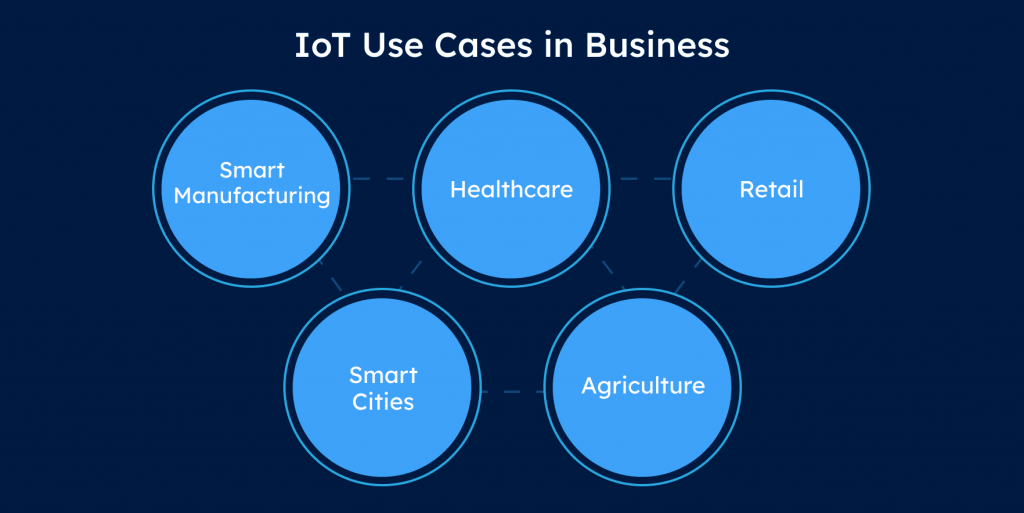
The IoT offers vital benefits across industries and scenarios. Let’s explore the top five key IoT use cases that highlight its transformative impact across various sectors:
IoT in smart manufacturing
In general, IoT helps manufacturers collect and analyze data in real time, which provides better insight into machine operations and monitors safety and working conditions. The examples of IoT that revolutionize today’s manufacturing include:
Predictive maintenance and reduced downtime
Smart IoT sensors allow companies to monitor their equipment in real time. They analyze when equipment might fail and ensure regular maintenance to keep production lines running smoothly. Afterward, sensors gather essential performance data, such as vibrations and temperature, and send it to central systems for analysis. They flag deviations.
Manufacturers use the collected data to schedule maintenance during planned downtimes. This approach significantly optimizes resources and enhances equipment reliability.
Digital twins and real-time production monitoring
A digital twin operates as a virtual model and replicates a physical entity, system, or process. In manufacturing, digital twins represent the behavior and condition of objects or processes. Leveraging AI and ML, they collect and analyze the data of physical items. As digital twins are adaptive, they help manufacturers monitor, predict, and optimize operations. A notable application of digital twins is in the laser scanning and reality capture sector, where manufacturing facilities utilize laser scan data to develop versatile digital twins that visualize critical processes and equipment.
Moreover, digital twins can generate immersive virtual environments to replicate actual manufacturing conditions. These simulations help:
- train employees and instruct them on safety protocols
- evaluate emergencies
- minimize workplace accidents with a risk-free training platform.
Supply chain optimization
IoT applications optimize supply chains in several ways:
- Updating the location of goods, thus ensuring timely alerts if shipments veer off course.
- Monitoring environmental factors like humidity and temperature and automatically adjusting conditions to prevent product damage.
- Automating inventory tracking, enhancing operational efficiency, and safety using artificial intelligence for minimal human intervention.
- Providing data analytics with real-time alerts to swiftly deal with weather events and accidents.
- Understanding what products people need in the market can help logistics managers fine-tune their strategies and ensure supply chain effectiveness.
IoT in healthcare
The evolution of IoT applications in healthcare is underway. From wearable health tech that tracks health parameters to AI-driven diagnostic tools and intelligent hospital systems, we are only scratching the surface of what’s possible in the future.
Remote monitoring and wearable health tech
Remote patient monitoring is becoming an insightful tool as it provides various perks for healthcare providers and patients.
IoT devices automatically gather health data such as heart rate, blood pressure, and temperature from patients outside a healthcare facility. In this way, patients don’t need to visit their providers for data collection. Later, when the data is processed by smart algorithms, doctors can suggest more personalized and effective treatments and instantly react to alerts.
IoT-driven hospital asset tracking and management
One more way the Internet of Things improves healthcare is through asset tracking and management. It means that healthcare providers can now use connected devices to monitor their equipment and supplies more effectively. Some real-life examples of asset tracking and management in action include:
- RFID tags on medical supplies and equipment allow providers to quickly find items and handle inventory.
- Sensors on hospital beds provide usage and maintenance data, which lowers downtime and increases patient safety.
- Smart refrigerators monitor temperatures and inventory levels of vaccines, medications, and other essential supplies, thus improving storage conditions.
IoT in retail
IoT solutions in retail transform the shopping experience with personalized interactions, optimized inventory management, and enhanced analytics for customer service. Below are key areas where these business solutions make an impact:
Personalized shopping experiences through IoT sensors
In-store retailers strive to connect deeply with customers by curating each purchase experience. Stores achieve this through technology that designs the purchasing journey. In this case, IoT applications may serve as the foundation for uncovering every shopper’s needs. An example is a smart camera that detects when customers traverse the same aisle multiple times. Moreover, shelf sensors ascertain which products engage a buyer based on the duration spent at a display. This information proves vital for providing personalized recommendations by matching recent successful shopping experiences with the current visit.
Consequently, the store can offer promotions and coupons to encourage a one-time visitor to become a loyal patron. This approach alleviates the decision-making burden for shoppers, who can spend less time on choices.
Smart shelves and automated inventory management
Smart shelves embody a major technological leap. These electronic shelves are built to monitor inventory in retail environments automatically. They can identify when items are purchased or taken. This integration simplifies stock tracking and makes retail operations more efficient.
IoT-based smart shelves deliver the following benefits:
- Dynamic inventory management: Smart shelves with sensors monitor product quantities to maintain optimal stock levels and avoid shortages or excess.
- Automated pricing adjustments: These systems automatically update prices based on promotions or market changes.
- Personalized suggestions: Advanced shelves use consumer data to recommend related items, enhancing the shopping experience.
AI-powered customer analytics for targeted marketing
AI-powered retailers see better engagement, increased sales, and important insights into customer preferences and shopping habits. AI tracks customer interactions across channels—online, in-store, and mobile apps—to identify trends like popular products and preferred shopping times. Additionally, AI reviews feedback from social media and customer comments to understand sentiment, allowing retailers to adapt their marketing strategies accordingly.
IoT in smart cities
Smart cities can use the Internet of Things (IoT) to reduce pollution, improve public safety, and improve city services. IoT devices track traffic, weather, air quality, and energy use. City planners can analyze this data to make smart choices that help everyone.
Traffic flow optimization and smart parking systems
Many cities are implementing IoT sensors to monitor parking spaces, as commuters spend about 17 hours annually looking for available spots. If residents know where to park, congestion, fuel consumption, and emissions can be significantly reduced.
Long-term analysis of traffic patterns, including vehicles and pedestrians, aids city planners in identifying transportation needs, such as additional roads, lanes, buses, and pedestrian pathways.
Furthermore, road and bridge sensors can assess the condition of the transportation infrastructure. When combined with AI, these sensors can detect problems before they escalate.
IoT-based waste management and energy efficiency
The growth of smart cities will further promote IoT integration in waste management. As urban regions work towards achieving zero-waste objectives, these solutions will be crucial in realizing these ambitions. With features like adaptive waste collection schedules and smart recycling centers, IoT will lead the way in sustainable urban living.
Let’s take a look at how the Internet of Things helps cities manage waste and maintain energy efficiency:
- Smart waste bins: Sensors check when waste bins are full and notify the collection teams. This makes the collection more efficient, reduces extra trips, and saves fuel and emissions.
- Route optimization: IoT finds the easiest waste collection routes, reducing fuel costs and expenses.
- Waste composition analysis: Sensors check what types of waste are present to improve recycling and support better management.
- Real-time monitoring: Devices provide up-to-the-minute energy use data, helping spot waste and improve operations. This reduces energy costs and boosts energy efficiency.
- Predictive maintenance: By looking at factors like vibration, energy use, and temperature, devices can predict when maintenance is needed, preventing equipment failures and cutting costs.
- Integration with renewable energy: IoT helps manage renewable energy sources more effectively, increasing their use and improving sustainability.
Public safety enhancements with real-time monitoring
Sensors and interlinked devices significantly enhance public safety by gathering data that empowers city officials to react swiftly to various incidents. Smart cities leverage IoT technology in several ways:
- Identify unusual behavior
- Analyze traffic trends
- Mitigate road dangers
Furthermore, integrated safety and security systems, such as biometric data and surveillance cameras, support a complete public safety strategy. This approach allows for effective communication and quick emergency responses.
IoT in agriculture
IoT applications in agriculture boost efficiency, optimize resource management, and enhance food safety:
Precision farming and IoT-powered irrigation systems
IoT-based precision farming employs GPS, sensors, and aerial devices to enhance crop management, boost production, and increase profitability. It optimizes resources like electricity, fuel, and water, supporting sustainable agriculture.
IoT technologies transform precision farming by delivering real-time insights into soil conditions, weather patterns, and crop health. With this information, farmers can make smarter choices about when to plant, how much fertilizer to use, and when to irrigate. This helps manage resources better and increases crop yields. For example, IoT sensors can keep track of soil moisture levels and automatically control irrigation systems to provide just the right amount of water. This not only minimizes waste but also helps conserve precious water resources.
Livestock monitoring and automated feeding systems
In livestock management, IoT devices like wearable sensors monitor vital signs, activity levels, and animal locations. This ongoing surveillance allows for early identification of health problems, which enhances animal welfare and lowers veterinary expenses. Furthermore, IoT-enabled automated feeding systems deliver precise feed according to each animal’s needs, which boosts growth rates and feed efficiency.
Climate control and smart greenhouses
Backyard gardeners love working with their plants and carefully tend to their needs. In contrast, commercial growers rely on smart greenhouses that use automated systems to maintain healthy plants without daily labor.
Smart greenhouses with IoT sensors monitor and control factors such as light, humidity, and temperature. These systems automatically maintain optimal growth conditions, improving crop yields and quality. By adjusting climate variables in real time, sensors help consume less energy and decrease operational costs in greenhouse agriculture.
Emerging IoT applications in business
IoT in financial services: fraud detection and security
As IoT solutions transform industries worldwide, the financial services sector is another example. These solutions produce large volumes of data to help detect unusual patterns and pinpoint possible fraud. Here are the ways companies can detect fraud and maintain security with IoT applications:
- Transaction monitoring: IoT sensors in ATMs and point-of-sale systems track transaction patterns to detect anomalies indicating fraud.
- Authentication: Wearable IoT devices and biometrics add layers of authentication, lowering unauthorized access risks.
- Integrated security networks: IoT connects various fraud detection systems, enhancing fraud prevention and detection capabilities.
IoT in hospitality: smart hotels and automated check-ins
The hospitality industry is also harnessing the power of IoT applications to craft smart hotel experiences and streamline operations. Here are the key examples of IoT that upgrade hospitality services:
- Check-ins and check-outs automation: IoT mobile apps let guests skip the usual front desk process, which cuts down wait times and improves their experience.
- Smart room management: Guests can use their devices to adjust lighting, temperature, and entertainment systems to personalize their stay.
- Operational efficiency: IoT devices track the number of people in a room and the energy used. They help plan cleaning schedules and lower energy costs.
IoT in logistics: fleet management and route optimization
In fleet management, IoT integrates telematics, sensors, and networks to analyze data from connected cars and drivers. This data helps managers optimize operations, enhance safety, cut costs, and make informed decisions. Here, the IoT use cases include:
- Real-time vehicle tracking: IoT telematics gives fleet managers real-time vehicle location, speed, and routes. This flexibility enables smart decisions like rerouting to avoid traffic, optimizing delivery schedules, and enhancing customer experience.
- Driver behavior monitoring: IoT devices track driver behaviors like speed and braking. Monitoring these promotes safer habits, reduces accidents and insurance costs, and encourages fuel efficiency savings.
- Route optimization: IoT systems analyze traffic, weather, and schedules to improve route efficiency, leading to reduced fuel consumption, faster delivery, and greater customer loyalty.
How to get started with IoT for your business
IoT projects often inspire high hopes. However, even if a company has the right people and tools, success is not guaranteed without the proper IoT implementation steps. Therefore, it is essential to understand why IoT should be used. Here is a simple guide to help you with this.
Key steps in implementing IoT solutions
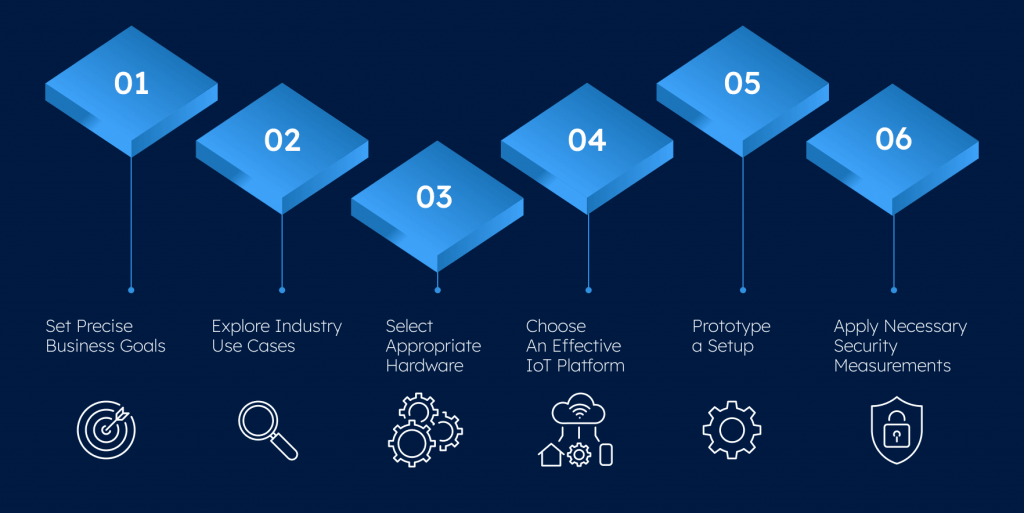
Set precise business goals: Determine the specific challenges that IoT can address within your organization. Clear objectives help ensure that your initiatives align with overarching business strategies.
You should identify:
- The short and long-term problem
- The aim for problem resolution with IoT
- The best solution method
- KPIs to monitor
Explore industry use cases: Research successful IoT applications in your industry to see how they can benefit you and what challenges they might present. For instance, manufacturing companies often implement IoT-based predictive maintenance systems to avoid machine failures and reduce downtime.
Select appropriate hardware: Choose devices and sensors compatible with your operational requirements and environmental conditions. For example, in logistics, GPS trackers and temperature sensors track the condition of perishable goods during transportation.
Choose an effective IoT platform: IoT platforms centralize and control IoT devices and networks. You can obtain these platforms from suppliers or develop them in-house. An effective IoT platform serves as the foundation of the network, with everything else built around it.
Prototype a setup: Before starting your IoT project, gather a diverse team of tech experts to assess the system, including IT and telecommunications specialists and relevant engineers. Then, plan the implementation strategy and test the prototype for effectiveness. Skills your IoT team may rely on after implementation include:
- Information systems expert for data storage
- Data scientist for data analysis
- Statistician for data quality control.
Apply necessary security measurements: IoT security breaches are common, so businesses must inform their data security officer of IoT projects to integrate data governance practices. Moreover, IoT security solutions can help minimize breaches.
These key initiatives encompass:
- robust endpoint security
- advanced communication protocols
- stringent access control
- comprehensive encryption techniques
- proactive fraud management.
Choosing the right IoT platform and service providers
An IoT platform serves as the core of any IoT solution. With countless IoT PaaS vendors in the market, a successful IoT solution demands an equally exceptional IoT platform. So, what essential architectural qualities should this platform have?
Scalability: IoT initiatives involve vast data and devices. To process extensive data efficiently, companies must adopt web-scale capabilities and new information management policies. This transition can be daunting for businesses facing master data management challenges.
Security: It requires effective risk management and privacy policy enforcement, monitoring, and response capabilities for potential threats, distributed access control across all IT assets
Configurability: IoT solutions should adapt to organizational needs.
Integration: Many organizations underestimate the complexities involved in integrating IoT projects. Key requirements include merging data and devices with enterprise IoT applications, SaaS products, mobile applications, and legacy systems.
Here are the recommendations to pay attention to when choosing the right IoT service provider:
1. Scalability
Most Internet of Things initiatives begin small, often with a pilot project. However, a scalability plan for future growth is crucial. IoT services partners must be well-equipped to scale their solutions effectively regarding device management, connectivity, and cloud services.
2. Comprehensive solutions
Choosing the right IoT partner is key to your success. Look for a provider that offers various services, including essential hardware, different ways to connect, effective device management, cloud options, and the ability to integrate with your current systems. This approach ensures that all parts of your ecosystem work well together and provides easy access to support when you need it.
3. Industry experience
Consider the provider’s experience in your industry. Each sector has unique IoT hardware and connectivity needs, so it’s best to choose a provider with a strong track record. They can deliver individual solutions that meet your needs and offer valuable insights based on their experience.
4. Flexibility
Flexibility is key when choosing an IoT technology provider. As your business evolves, having a partner who can adapt to your needs will be invaluable.
5. Security
Before selecting a potential partner, analyze their security protocols and determine how well their measures align with your use case.
6. Data integration
IoT data is only valuable when you can use it to enhance your business operations. Ensure your future services provider can seamlessly deliver data from the cloud to your platform for effective analytics and business insights.
7. Support
Assess the support options a potential vendor offers and how they align with your solution. Developing an IoT device solution involves more than just acquiring IoT devices; you must also consider additional expenses, such as support, when calculating your smart solution’s total cost of ownership.
The journey to building an effective IoT solution is like constructing a bridge between the physical and digital worlds—precision, adaptability, and expertise are essential. While choosing the right platform and provider may seem daunting, businesses must remember that IoT is not a one-size-fits-all endeavor. It demands solutions tailored to unique industry challenges, security requirements, and scalability goals. This is where experience and innovation make the difference.
At SoftTeco, we craft intelligent, future-ready IoT solutions from the ground up, ensuring seamless integration, security, and efficiency at every step. With the right partner, IoT is not a challenge to navigate—it’s a new opportunity to redefine what’s possible.
Future trends in IoT for businesses
IoT is changing our future with many innovations. But how will the Internet of Things impact businesses? With smart systems to improve operations, blockchain to enhance security, and sustainable practices to optimize resources, companies can become more efficient, secure, and environmentally friendly.
Growth of autonomous IoT-driven systems
IoT innovations fuel the development of autonomous systems, including self-driving cars and automated industrial machinery. These technologies enhance efficiency and eliminate the need to rely on human labor. Here are some more examples of such systems:
1. Autonomous vehicles: Self-driving cars and trucks use IoT sensors and AI to navigate and make decisions on the road. For example, Volvo and DHL Supply Chain launched driverless freight trucks with advanced safety features that operate between Dallas and Houston.
2. Autonomous drones: In Hungary, researchers created a swarm of 100 drones that can make real-time decisions independently, inspired by how animals move. This technology holds exciting possibilities for meteorology, land surveying, goods delivery, and precision agriculture.
3. Autonomous robots: Devices such as warehouse robots and vacuum cleaners navigate, manipulate objects, and interact with their environment without human supervision.
Blockchain integration for secure IoT transactions
Blockchain and the Internet of Things (IoT) are game-changing technologies in finance. IoT allows devices to collect transaction data, while blockchain protects it to ensure security and reliability. Together, they build trust and reduce the risk of fraud, ultimately reinforcing the integrity of financial systems.
Sustainability-focused IoT innovations
The fusion of IoT technologies into sustainability efforts has led to groundbreaking solutions that effectively address environmental issues. Some notable examples include:
- Smart energy management: IoT devices can monitor energy usage in buildings, helping us save money while reducing our carbon footprint.
- Smart waste management: IoT sensors installed in waste bins give us real-time updates on their capacity. This allows waste collection services to better plan routes, save fuel, and reduce emissions.
- Air quality monitoring: Sensors help monitor air pollution levels, allowing us to take quick action to protect public health and well-being.
- Water management: Organizations can easily detect leaks and monitor water quality, which encourages citizens to use water more wisely.
- Sustainable agriculture: IoT technology assists farmers by improving irrigation methods and monitoring crop health, leading to more efficient resource use in farming practices.
Conclusion
Undoubtedly, the Internet of Things in business is becoming a universal tool. It offers solutions that impact essential sectors, such as manufacturing, agriculture, smart cities, retail, healthcare, and more. These solutions help reduce costs, automate processes, and track and analyze large volumes of data critical for making informed decisions and maintaining equipment.
With rapid advancements and competitive advantages, now is the best time to invest in IoT applications, considering their benefits for business growth.
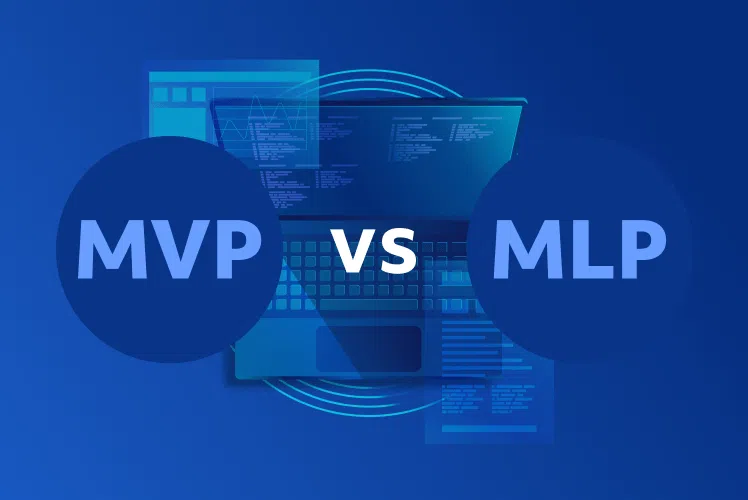

Comments